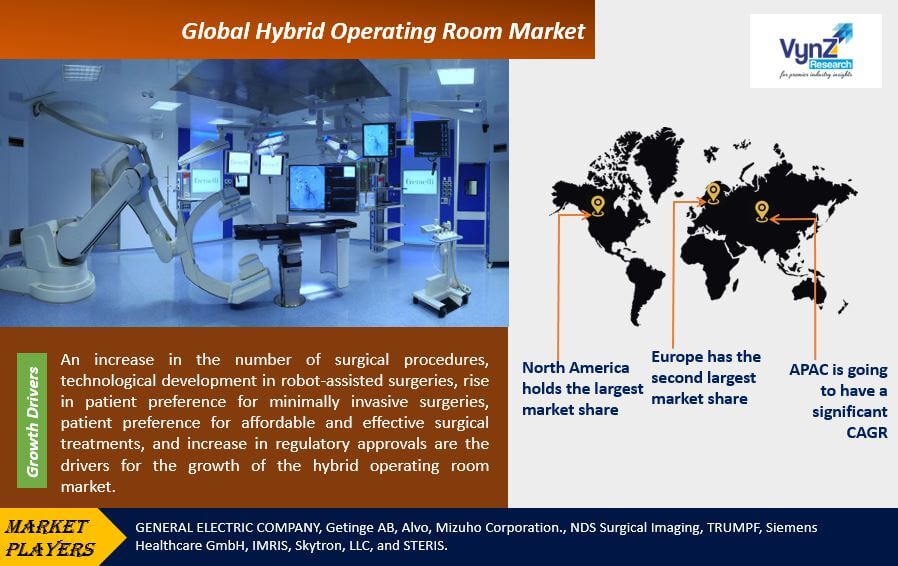| Status : Published | Published On : Apr, 2024 | Report Code : VRHC1250 | Industry : Healthcare | Available Format :

|
Page : 180 |

Global Hybrid Operating Room Market – Analysis and Forecast (2025-2030)
Industry Insight by Component (Intraoperative Diagnostic Systems (Angiography System, MRI System, CT Scanner, and Others), Operating Room Fixtures(Operating Table, Operating Room Light, Radiation Shield, and Others), Surgical Instruments, Audio Display System and Tools, and Others), by Application (Neurosurgical, Cardiovascular, Thoracic, Orthopedic, and Others), by End-User (Hospitals and Surgical Centers and Ambulatory Surgical Centers), and by Geography (North America, Europe, Asia-Pacific, Middle East, South America and Rest of the World)
Industry Overview
The Global Hybrid Operating Room Market is expected to grow to reach USD 1.98 billion by 2030 at a CAGR of 10.9% during the forecast period ranging from 2025 to 2030.
A hybrid operating room refers to a surgical space or surgical theater equipped with medical imaging devices such as fixed C-Arms, CT scanners, or MRI scanners. The purpose of these specialized spaces is to support complex open and minimally invasive surgeries as well as high-quality interventional imaging procedures. The process allows patients to receive treatment within the same facility for complex procedures such as neurosurgeries, cardiovascular surgeries, orthopedic surgeries, and thoracic surgeries. In addition, it can also be used for other treatments such as biopsy, laparoscopic surgery, and trauma surgery.
The growth of the Global Hybrid Operating Room Market is the result of the wide range of advantages offered in the form of ease of conducting minimal invasive surgeries, lower administrative costs, saving patients time from multiple surgeries, and lower recovery time, which also fuels the growth of the hybrid OR market.

The risks associated with hybrid procedures and the high cost of establishment and operation limit the growth of the hybrid OR market. In addition, the shortage of skilled surgeons to manage these procedures further impedes market growth. On the flip side, the rise in demand for novel technologies such as robotic platforms and high adoption of robot-assisted surgeries, accessibility of such treatment options, and the ability of the surgeons and healthcare staff to fight against infection due to comprehensive control systems provide novel growth avenues for the hybrid operating room market.
Hybrid Operating Room Market Segmentation
The Global Hybrid Operating Room Market is divided by components into intraoperative diagnostic systems (angiography systems, MRI systems, CT scanners, and others), operating room fixtures (operating tables, operating room lights, surgical booms, and radiation shields), surgical instruments, audio display systems and tools, and other segments. Out of these, the intraoperative diagnostic system segment will hold the major share of the market due to the high installation costs of products, higher usage in minimally invasive surgeries and better guidance to surgeons and anesthesiologists.
Insight by Application
The Global Hybrid Operating Room Market is divided by applications into cardiovascular, neurosurgical, thoracic, orthopedic, and other segments. Out of these, the cardiovascular segment will have the largest market share due to the growing preference by heart surgeons, the rise in the number of cardiovascular disease cases, the growing adoption of endovascular procedures during cardiovascular surgeries, the rise in demand for minimally invasive surgeries, and rise in the number of patients suffering from obesity. The thoracic segment is also expected to grow at a higher CAGR due to the growing number of such surgeries and rising awareness among medical professionals towards the cost and therapeutic efficacy.
Insight by End-User
The Global Hybrid Operating Room Market is divided by end users into hospitals, surgical centers, and ambulatory surgical centers. Out of them, the hospital and surgical center segment is expected to grow more due to the rise in the number of diagnostic and surgical procedures performed in the hospitals, as well as the growing emphasis on more effective and timely disease management.
Global Hybrid Operating Room Market Report Coverage
|
Report Metric |
Details |
|
Historical Period |
2018 - 2023 |
|
Base Year Considered |
2024 |
|
Forecast Period |
2025 - 2030 |
|
Market Size in 2024 |
U.S.D. x.xx Billion |
|
Revenue Forecast in 2030 |
U.S.D. 1.98 Billion |
|
Growth Rate |
10.9% |
|
Segments Covered in the Report |
By Component, By Application and By End-User |
|
Report Scope |
Market Trends, Drivers, and Restraints; Revenue Estimation and Forecast; Segmentation Analysis; Impact of COVID-19; Companies’ Strategic Developments; Market Share Analysis of Key Players; Company Profiling |
|
Regions Covered in the Report |
North America, Europe, Asia-Pacific, Middle East, South America and Rest of the World |
Industry Dynamics
Industry Trends
One of the most significant trends in the industry is the rise in favorable government norms and policies to promote its adoption. Another notable trend is the growing adoption of minimally invasive surgeries among surgeons as well as patients. There is also a huge investment made in R&D by different market players to develop more innovative products and effective technologies to improve healthcare systems for patients. In addition, higher integration of robotic-assisted surgery systems into hybrid ORs has also been noticed, which allows surgeons to perform complex surgical procedures with more skill and enhanced precision to offer better outcomes.
Hybrid Operating Room Market Growth Drivers
The most influencing factor for the growth of the hybrid OR market is the rise in the number of surgical procedures and the growing patient preference for inexpensive and effective surgical treatments. In addition, rapid tech developments in robot-assisted surgeries and an increase in regulatory approvals are also driving the market growth. Apart from that, the fact that patients now are demanding minimally invasive procedures that reduce treatment costs, hospital stays, and morbidity and expedite recovery propels market growth. The benefit of hybrid ORs that enable surgeons to perform with higher precision due to real-time imaging guidance also promotes market growth. The growing prevalence of chronic and infectious diseases and specific conditions like cancer, cardiovascular diseases, and neurological disorders that need complex surgical interventions also drive the market growth. Furthermore, the growing aging population who are more vulnerable to chronic diseases needs specialized surgical interventions, which the versatile platform of hybrid ORs helps to address despite challenges such as multimorbidity and anatomical complexities. This further fuels the market growth.
Hybrid Operating Room Market Challenges
The complexity of the deployment of these systems and integrating them into the existing workflows of the healthcare systems hinders the growth of the hybrid operating room market to some extent. This is mainly because proper and effective coordination between different departments, such as cardiology, radiology, and surgery, is needed to create efficient procedures and organize patient care pathways.
Hybrid Operating Room Market Opportunities
The rise in developing economies worldwide, the strong economic conditions of developed countries, and the increase in high-quality surgical outcomes offer novel growth opportunities for the hybrid operating room market during the forecast period. In addition, there is a huge investment made by the market players into research and development in healthcare, which also offers growth opportunities.
Recent Developments By the Key Players
MIZUHO Corporation integrated the sales division of Mizuho Medical Co., Ltd. into its international sales division. This restructuring aims to enhance operational effectiveness and improve customer communication.
NDSsi introduced the 27-inch Radiance Ultra, a next-generation surgical visualization platform. It features an ultrabright LED backlight and the proprietary Medi-Match color calibration technology, overcoming reflections and glare in high ambient light environments to enhance image clarity.
Hybrid Operating Room Market Geographic Overview
North America is expected to continue holding the largest share of the market during the forecast period due to technologically advanced operating room equipment. The growing number of hospitals and ambulatory surgery centers in the region is also promoting market growth along with the growing senior population.
The European market is also expected to grow significantly during the same period due to higher investments in R&D and the significant growth in the number of surgical outcomes.
On the other hand, the APAC market is expected to grow at a higher CAGR due to the ongoing improvement in healthcare infrastructure and the rise in the number of hospitals equipped with advanced medical facilities. It is also attributed to the significant development in R&D and the notable improvements made in healthcare reforms. Tech development in a hybrid operating room setting, as well as the rise in medical tourism, also results in the growth of the market in this region.
Hybrid Operating Room Market Competitive Insight
The companies in the hybrid operating room market are engaging in partnerships and collaborations in order to increase their share in the market. Also, there are strategic alliances among multinational players and regional and small-scale OEMS to sustain their position in the hybrid operating room market
Some of the leading players operating in the global hybrid operating room market are :
- GENERAL ELECTRIC COMPANY
- Getinge AB
- Alvo
- Mizuho Corporation
- NDS Surgical Imaging
- TRUMPF
- Siemens Healthcare GmbH
- IMRIS
- Skytron LLC
- STERIS
The Hybrid Operating Room Market report offers a comprehensive market segmentation analysis along with an estimation for the forecast period 2025–2030.
Segments Covered in the Report
- By Component
- Intraoperative Diagnostic Systems
- Angiography System
- MRI System
- CT Scanner
- Others
- Operating Room Fixtures
- Operating Table
- Operating Room Light
- Radiation Shield
- Others
- Surgical Instruments
- Audio Display System and Tools
- Others
- Intraoperative Diagnostic Systems
- By Application
- Neurosurgical
- Cardiovascular
- Thoracic
- Orthopaedic
- Others
- By End-User
- Hospitals & Surgical Centers
- Ambulatory Surgical Centers
Region Covered in the Report
- North America
- U.S.
- Canada
- Mexico
- Europe
- Germany
- U.K.
- France
- Italy
- Spain
- Russia
- Rest of Europe
- Asia-Pacific (APAC)
- China
- Japan
- India
- South Korea
- Rest of Asia-Pacific
- Rest of the World (RoW)
- Brazil
- Saudi Arabia
- South Africa
- U.A.E.
- Other Countries
.png)
Source: VynZ Research
Frequently Asked Questions
Purchase Options
Latest Report
Research Methodology
- Desk Research / Pilot Interviews
- Build Market Size Model
- Research and Analysis
- Final Deliverabvle
Connect With Our Sales Team
- Toll-Free: 1 888 253 3960
- Phone: +91 9960 288 381
- Email: enquiry@vynzresearch.com
Hybrid Operating Room Market
